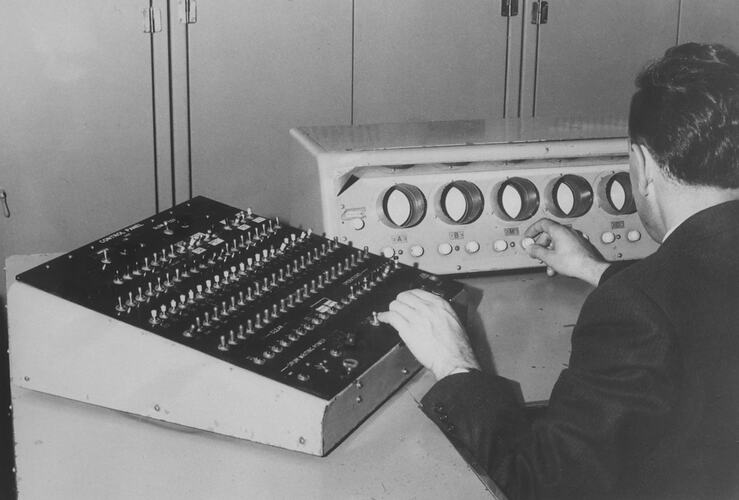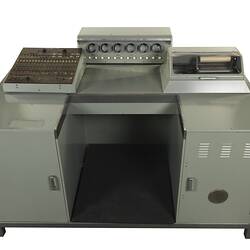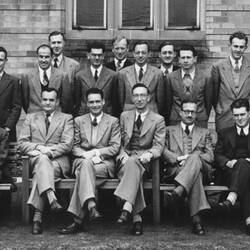Summary
CSIRAC maintenance engineer, Jurij Semkiw, at the console of the CSIRAC Computer, with his left hand on the switch panel and his right hand on the cathode ray tube controls. CSIRAC was at the University of Melbourne. It is thought this photo was taken in 1964, when CSIRAC was being de-commissioned.
CSIRAC, originally known as CSIR Mark 1, was built by the Commonwealth Council for Scientific and Industrial Research [CSIR], Sydney, in 1949 and was the fourth computer in the world. It was later transferred to the University of Melbourne. Designed by Trevor Pearcey and engineered by Maston Beard, CSIRAC completed more than 1000 projects by the time it was turned off in 1964. It is currently housed at Museum Victoria.
This is one of a set of 35mm slides showing computers, computer components, computer structure diagrams and computer programmimg instructions, probably used as aids in teaching computing subjects. The diagrams and instructions relate to several pioneer models and systems of stored program computers dating back as far as the 1950s and including CSIRAC, Cirrus, Atlas, IBM System/360 , CDC 6600 System, and Illiac IV. The slides belonged to Trevor Pearcey.
Trevor Pearcey, who pioneered computing in Australia and designed CSIRAC, held a variety of academic positions in computing at Caulfield. CSIRAC was on display there from 1980 until 1992. [Caulfield Institute of Technology became Chisholm Institute of Technology in 1982 and Monash University Caulfield Campus in 1990].
Description of Content
Maintenance engineer Jurij Semkiw at the console of the CSIRAC Computer.
Physical Description
35mm colour slide
More Information
-
Collection Names
-
Collecting Areas
-
Acquisition Information
Donation from Steve & Connie Kormas, 22 Feb 2001
-
Place & Date Depicted
University of Melbourne, Parkville, Greater Melbourne, Victoria, Australia, circa 1964
-
Person Depicted
Mr Jurij Semkiw, University of Melbourne, Parkville, Greater Melbourne, Victoria, Australia, circa 1964
-
Creator
-
Individuals Identified
JURIJ SEMKIW
-
Format
Slide, 35 mm, Colour
-
Classification
-
Category
-
Discipline
-
Type of item
-
Overall Dimensions
50 mm (Length), 50 mm (Width)
-
Keywords
Computer Engineering, Computer Programming, Computers, Computing, CSIRAC (Computer)




